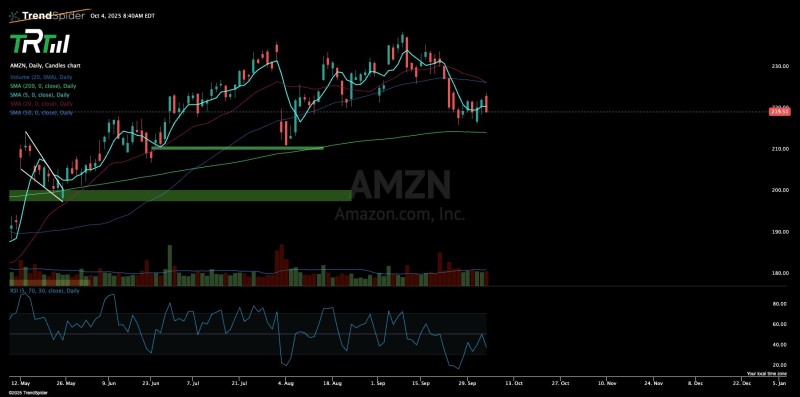Amazon (AMZN) shares have reached a pivotal technical zone, with the stock now testing its long-term 200-day moving average. This level typically serves as a key indicator of investor sentiment, distinguishing temporary pullbacks from deeper corrections. As volatility increases across mega-cap technology stocks, market participants are closely monitoring whether Amazon can maintain this support or face further downside.
Amazon Approaches Key Technical Level
On the daily chart, Amazon (AMZN) is currently trading at $219.51, showing signs of stabilization following September's decline. Trader John The Rock Trading noted that the most straightforward scenario would involve AMZN retesting the 200-day moving average to provide clarity before the next directional move.

The stock has trended lower from its summer highs but now sits just above the 200-day simple moving average (SMA), a widely monitored level that frequently acts as support during market pullbacks.
Chart Analysis: Technical Developments
The chart reveals several important technical patterns:
- 200-Day SMA Support: The long-term moving average sits directly beneath current prices, representing a critical test for buyers
- Short-Term Resistance: The downward-sloping 20-day SMA is capping rally attempts, reinforcing near-term selling pressure
- Volume Dynamics: Selling volume surged in late September but has since diminished, suggesting potential stabilization
- RSI Indicator: The RSI has recovered from oversold territory, indicating bearish momentum may be weakening
- Support Zone: Significant demand exists in the $205–$210 range, which has been tested multiple times throughout the summer
Several factors have contributed to pressure on AMZN recently. Rising Treasury yields and slowing consumer spending have weighed on growth and retail stocks. Investors are exercising caution ahead of Amazon's earnings report, with particular attention on AWS growth rates, retail margins, and advertising revenue performance. Additionally, capital rotation into cyclical sectors like energy and financials has reduced momentum for large technology names.
 Usman Salis
Usman Salis

 Usman Salis
Usman Salis


